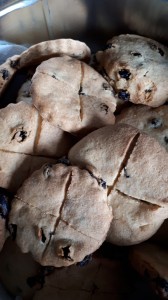By Paula Guran
The farther we’ve gotten from the magic and mystery of our past, the more we’ve come to need Halloween. It’s a festival of fantasy, a celebration of otherness, the one time each year when the mundane is overturned in favor of the bizarre, and everyone can become anyone or anything they wish. At its core, Halloween is a chance to confront our most primal fear—death—and attempt to control it or, at the very least, mock it. Ancient beliefs, religious meanings, a multitude of ethnic heritages, diverse occult traditions, and the continual influence of popular culture have combined to make Halloween a beloved holiday as well as a booming commercial industry.
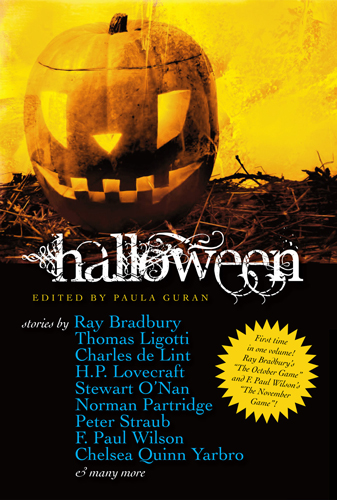 Festivals emphasizing the supernatural and death are common in almost all cultures and probably date back to prehistory. The first recorded festivals for the dead were those of the ancient Egyptians. Egyptians had no fear of the deceased, no concept of appeasing unquiet spirits. They offered love, respect, and rites for the continuance of a happy afterlife; they communed with dead ancestors and loved ones. Their rituals included bringing food to tombs and sharing it with the deceased. One of the oldest festivals (there were several) was Wag, celebrated on the first month of the first season of the year, the month of Akhet—meaning “inundation”—the season of the Nile’s annual flood. (Various sources disagree on Akhet’s correspondence to our calendar; dates vary from as early as June 19 to as late as mid-August.) Wag evidently including colorful processions, music, offerings of food and drink for the dead, and hearty feasting and drinking for the living. References are made to “shouts of joy” raised at the Wag festival.
Festivals emphasizing the supernatural and death are common in almost all cultures and probably date back to prehistory. The first recorded festivals for the dead were those of the ancient Egyptians. Egyptians had no fear of the deceased, no concept of appeasing unquiet spirits. They offered love, respect, and rites for the continuance of a happy afterlife; they communed with dead ancestors and loved ones. Their rituals included bringing food to tombs and sharing it with the deceased. One of the oldest festivals (there were several) was Wag, celebrated on the first month of the first season of the year, the month of Akhet—meaning “inundation”—the season of the Nile’s annual flood. (Various sources disagree on Akhet’s correspondence to our calendar; dates vary from as early as June 19 to as late as mid-August.) Wag evidently including colorful processions, music, offerings of food and drink for the dead, and hearty feasting and drinking for the living. References are made to “shouts of joy” raised at the Wag festival.
Modern Halloween is highly influenced by and probably originated with the ancient Celtic festival of Samhain. About 500–1000 BCE, the Celts—who at the time populated Ireland, Scotland, Wales, England, Brittany, and northern France—celebrated the first day of winter as their New Year. Winter began, in the climate of Northern Europe, in November. The end of summer marked a radical change in the daily life of the pastoral Celts. The herds were brought down from the summer pastures in the hills, the best animals put to shelter, and the rest slaughtered. For the Celts, the period we now consider the end of October and start of November was a time of preparation, festival, and plenty before the coming of the long dark winter.
As agriculture became a part of their lives, harvest time became a seasonal activity. The communal celebration became known as Samhain (there are a number of variant spellings, including Samfuin, Samhuinn, Samain). Linguistically, the word evidently simply combines the Gaelic words sam for “end” and fuin for “summer”—End of Summer. Samhain may have just been one night—October 31—or it may have stretched out over three days—October 31, November 1, and November 2.
How Samhain was actually celebrated is unknown. Since the Celts left no written records, what we do know of it comes from secondary sources. Our conjectures are, at best, relatively educated guesses, but they still inform much of our modern Halloween mythos.
Although the bounty of nature and the natural change of seasons were important aspects of Samhain, it was also a festival of the supernatural. Samhain was the turning point of the year for a people who believed that even minor “turning points”—the change from one day to the next, the meeting of sea and shore—were magical. The turning of the year, leaving the season of sunshine and light and entering the darkness of winter, was the most powerful and sacred of such junctures. The worlds of the living and of the dead were very close to one another at Samhain, the veil between the two at its thinnest. The living could communicate with those who had gone beyond; the dead could visit the living. In Celtic times, the dead were not considered evil or particularly dreaded so much as consulted and honored as ancestral spirits and guardians of the wisdom of the tribe. Celtic priests, the Druids, contacted the dead in order to divine the future and make predictions for the community.
[In Halloween lore of the last two centuries or so, references are made to Samhain as a deity or Celtic “Lord of the Dead.” There is no evidence for such a god. The fallacy seems to have arisen in the 1770s before improved translation of Celtic literary work and modern archaeology. It can be traced to the writings of a Col. Charles Vallency (who, for some reason, was trying to prove that the Irish originally came from Armenia) and then was later perpetuated by Lady Jane Francesca Wilde (Oscar’s mum) in her mid-nineteenth century book Irish Cures, Mystic Charms and Superstitions. It has gone on to be unquestioningly and inaccurately repeated in many sources over the years.]
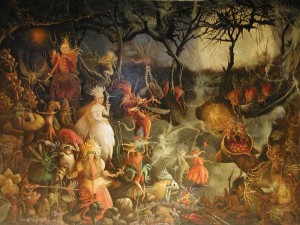 Although possibly later developed as post-Christian mythology, the Celts may have believed in faeries or similar magical creatures. They did not believe in demons or devils, but they may well have had these not-so-nice entities to deal with. Resentful of humans taking over the world, the faerie-folk were often thought to be hostile and dangerous. During the magical time of Samhain the faeries were even more powerful than usual. Humans might be lured astray by faeries. These unfortunates would then be lost in the fairy mounds and trapped forever.
Although possibly later developed as post-Christian mythology, the Celts may have believed in faeries or similar magical creatures. They did not believe in demons or devils, but they may well have had these not-so-nice entities to deal with. Resentful of humans taking over the world, the faerie-folk were often thought to be hostile and dangerous. During the magical time of Samhain the faeries were even more powerful than usual. Humans might be lured astray by faeries. These unfortunates would then be lost in the fairy mounds and trapped forever.
Faeries and their kin weren’t the only ones causing mischief. The yearly turning point was also seen as a suspension of ordinary space and time. For order and structure to be maintained for the rest of the year, chaos would reign during Samhain. Humans supposedly indulged in cross-gender dressing, tricks, and high jinks. On the practical side, such behavior was an outlet for high spirits before the confining winter came.
We know very little of Druidic religious rituals, but we do know Samhain was one of four “Fire Festivals” of the Celts. Hearth fires were extinguished to symbolize the coming “dark half” of the year, then re-lit from Druidic fires to signify the return and continuance of life. Bonfires were also part of this observance.
Halloween can’t really be considered a direct outgrowth of ancient Celtic practices. Other cultural elements—including various harvest festivals—eventually became part of Halloween customs. Over the centuries traditions have been both correctly and incorrectly attributed to the Celts. Sometimes this has been done with an appreciation of the ancient ways. More often, cultural-centrism and historic revisionism so colored thinking that the past was unfairly interpreted.
Early Christian missionaries intentionally identified contact with the supernatural as experiences originating with the Devil and inherently evil. The Druids, since they adhered to “false gods” were, therefore, worshippers of Satan. Later religious prejudice also lumped pagans in with Satan-worship and the resulting misinformation has been further propitiated. (For that matter, as we shall see, animosity between Catholics and Protestants resulted in the alteration of some Halloween lore.)
As with other pre-Christian practices, Samhain was eventually absorbed by the Church. In AD 609 or 610, May 13 was designated as a day to honor the Virgin Mary and the martyred saints. In the eighth century, Pope Gregory III (731-741) fixed November 1 as the anniversary for all saints (including the martyrs). October 31 became All Hallows’ Eve [Hallowmas or Halloween], the evening before All Hallows Day [All Saints Day] on November 1. (The word “hallow” was used in the Middle Ages as a synonym for “saint.”) Gregory IV (827-844) extended the celebration of All Hallows Day to the entire Church.
The old beliefs did not die out so easily and just honoring saints was not enough to replace the notion of a time of year when the dead could travel the earth. A more abstract holiday commemorating all the faithful departed on November 2 began to be marked as early as the ninth century. Although Odilo, Abbot of Cluny (c. 962-1048), actually instituted the date. By the end of the thirteenth century, it was accepted by the entire Church.
Not only did the Church give the holiday its popular name, it also sanctified the custom of remembering the dead on the eve of November 1. Other pagan traditions and religious practices were adapted by the Church and readapted by the people. “Soul cakes” were baked and given to the town’s poor in exchange for their prayers to help the dead in Purgatory enter heaven more quickly. Eventually, young men and boys went “souling” from house to house, singing and asking for food, ale, and money rather than cakes.European beliefs began mixing this type of concern for the spirits of the dead and traditions of welcoming the dear departed with a fear of malevolent otherworldly manifestations. The Church associated anything supernatural with evil and the devil, so it became something to fear. Gifts of food and drink might welcome the dead, but they were also offered to keep less friendly ghosts and whatever else might be unnaturally walking in our world at bay; bonfires were now lit to frighten the Devil away.
On October 31, 1517 Martin Luther, intending to stir debate, posted his Ninety-five Theses on the door of the Wittenberg Castle Church. (An occasion still marked in Lutheran churches as Reformation Sunday.) The religious reformation he sparked eventually did away with the celebration of Halloween for many Europeans. Reformation Protestants did away with the observance of saints’ days and without the “hallows” one can not have All Hallows’ Eve.
The English, however, managed to preserve some of the secular traditions of the holiday with Guy Fawkes Day. (In 1605 a group of English Roman Catholics conspired to blow up Parliament, King James I, and his heir on November 5. They evidently hoped that in the confusion following, the English Catholics could take over the country. What came to be known as the Gunpowder Plot was foiled and in January 1606 Parliament established November 5 as a day of public thanksgiving. The day became known as Guy Fawkes Day for a conspirator who was arrested and, under torture, revealed the names of the other plotters.) Guy Fawkes Day borrowed a great many of the traditions used to mark Halloween that had fallen just six days before. Bonfires, pranks, begging, and dressing in costume became part of the occasion. In some parts of England, the festivities were virulently anti-Catholic.
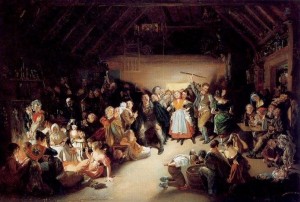 In the seventeenth century, immigrants brought a variety of traditions, beliefs, customs, and superstitions to what would later become the United States of America. The Puritan influence in New England left little room for any form of Halloween. Guy Fawkes Day (and its attendant anti-Catholicism), however, was celebrated until the Revolution. The Puritans also brought their fear of witchcraft and a history of persecuting witches to the colonies. Anglican settlers in Virginia brought not only commemoration of saints days, but a typically seventeenth-century English belief in the occult. Many Germans who settled in the tolerant Quaker-run state of Pennsylvania had pronounced supernatural beliefs and mystical ideas. Catholics in Maryland and other colonies retained their Halloween-connected religious traditions. Spanish Catholic influence was felt in Florida. African slaves imported a belief in an active spirit world into the southern colonies Post-revolutionary America saw the popularization of harvest “play parties.” These community get-togethers were non-religious and—unlike other fall gatherings which were task-oriented for sorghum-making, corn husking, apple picking and paring, and the like—were just for fun. The early autumn parties often featured feasting on and fortune-telling games played with apples, pumpkins, and nuts (all seasonally plentiful) and the telling of spooky tales. A tradition of mischief-making on the night of October 31 was common in some communities as well.
In the seventeenth century, immigrants brought a variety of traditions, beliefs, customs, and superstitions to what would later become the United States of America. The Puritan influence in New England left little room for any form of Halloween. Guy Fawkes Day (and its attendant anti-Catholicism), however, was celebrated until the Revolution. The Puritans also brought their fear of witchcraft and a history of persecuting witches to the colonies. Anglican settlers in Virginia brought not only commemoration of saints days, but a typically seventeenth-century English belief in the occult. Many Germans who settled in the tolerant Quaker-run state of Pennsylvania had pronounced supernatural beliefs and mystical ideas. Catholics in Maryland and other colonies retained their Halloween-connected religious traditions. Spanish Catholic influence was felt in Florida. African slaves imported a belief in an active spirit world into the southern colonies Post-revolutionary America saw the popularization of harvest “play parties.” These community get-togethers were non-religious and—unlike other fall gatherings which were task-oriented for sorghum-making, corn husking, apple picking and paring, and the like—were just for fun. The early autumn parties often featured feasting on and fortune-telling games played with apples, pumpkins, and nuts (all seasonally plentiful) and the telling of spooky tales. A tradition of mischief-making on the night of October 31 was common in some communities as well.
African beliefs and customs were imported with slaves beginning in the seventeenth century, but in the early nineteenth century, Haitians and others fleeing unrest in the Caribbean strengthened the Voudoun culture in the South and mixed new mythologies of the dead, witchcraft, and divination into the Halloween cauldron.
Almost 7.4 million new immigrants from all over the world came to the United States between 1820 and 1870 and each nationality brought its own traditions and customs. Spanish and Mexican Catholic traditions of el Día de los Muertos (the Day of the Dead) were strong in the Southwest. But the Irish had the greatest influence on the overall celebration of American Halloween. (From 1825 to 1845, Irish famines drove 700,000 Irish Catholics to the U.S. Another 300,000 entered between 1847 and 1854.)
In County Cork, All Hallows was marked with a mummers’ procession of young men claiming to be followers of Muck Olla (a boar from Irish folk tales). Led by Lair Bhain (White Mare) who wore a horse’s head and white robes, the group went from house to house noisily beseeching householders to impart food, drink, or money in return for a promise of prosperity in the coming year. Similar masquerades were popular in other Irish locales.
Young Irish women and girls marked the night with various methods of telling the future. The divinations most commonly foretold the identity of future spouses or one’s destiny in love.
 Although the jack o’ lantern did not start out as a lantern at all, the Irish were instrumental in the evolution into this now-quintessential symbol of the season. “Jack o’ lanterns,” like “will-o’-the-wisps,” was originally a name for the flickering light produced by ignition of swamp gas, the gaseous product of decomposing organic matter consisting of methane and phosphine (or possibly piezoelectricity generated by tectonic strain). “Jack o’ lantern” was also used in a folktale—with many variations in many cultures—as the name of a man with a lantern who tricks the Devil.
Although the jack o’ lantern did not start out as a lantern at all, the Irish were instrumental in the evolution into this now-quintessential symbol of the season. “Jack o’ lanterns,” like “will-o’-the-wisps,” was originally a name for the flickering light produced by ignition of swamp gas, the gaseous product of decomposing organic matter consisting of methane and phosphine (or possibly piezoelectricity generated by tectonic strain). “Jack o’ lantern” was also used in a folktale—with many variations in many cultures—as the name of a man with a lantern who tricks the Devil.
Irish villagers have used carved-out turnips and occasionally beets—abundant in late autumn—to make cheap lanterns with which to light their way as the evenings darkened toward winter. (The term “jack o’ lantern” first appeared in print in 1750. The reference was to a night watchman or a man carrying a lantern. The meaning applied to carved pumpkins is first attested, in the U.S., in 1837.) Some say these vegetable lights were carved or painted with scary faces to frighten the spirits away on Halloween. In the U.S. the pumpkin supposedly took the place of the turnip, but the abundant squash may have, at first, merely been a seasonally convenient way to used short candle stubs.
Halloween pranking may also have been an Irish import. Probably originally an outlet for mischief that could be blamed on supernatural entities, the pranks were primarily only slightly bothersome—a cabbage tossed down a chimney or knocking on doors and running away. American pranking evolved into slightly more troublesome endeavors such as moving gates or tying them shut, disassembling a wagon or carriage on a barn roof, soaping windows, stealing doormats, overturning outhouses, blocking roads with bales of hay, and “egging” houses.
Pranksters aside, by the 1880s upper and middle-class Americans thought of Halloween as a quaint holiday brought to America by genteel English people. This seems to have been the result of the popular fiction and articles in children’s and ladies’ periodicals of the day. They downplayed Irish Catholic connections and provided social tips on entertaining with parties for children, young adults or both. Parlor games (such as bobbing for apples and jumping over candlesticks) were popular. And although death and magic were de-emphasized, divination—especially that involving romance—was a major part of the revelry. Halloween was seen as much of an occasion for matchmaking as for mild fright. Ghost stories in the ladies’ magazines became less involved with ghosts and more inclined to be tales of love with mildly Gothic trappings.
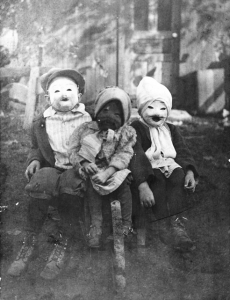 By the beginning of the twentieth century, middle-class Halloween became more of a children’s holiday full of harmless amusements. Parties, scavenger hunts, and other games became the focus. Scary and eerie elements were sanitized into safe, folkloric fun.
By the beginning of the twentieth century, middle-class Halloween became more of a children’s holiday full of harmless amusements. Parties, scavenger hunts, and other games became the focus. Scary and eerie elements were sanitized into safe, folkloric fun.
Among the lower classes, however, Halloween remained a night of rough mischief. It became an increasingly destructive way to for poor city dwellers to vent their frustrations. By the 1920s vandalism was no longer confined to tipping over outhouses and soaping windows. Severe property damage, fires, and cruelty to animals and people became all too common. Local civic groups mobilized to deal with the “Halloween problem.” Various charitable and community activities—raking leaves, neighborhood clean-ups, property improvements—were organized with young participants treated to parties as a reward. Children were encouraged to go door to door and receive treats instead of making trouble. By the 1930s these “beggar’s nights” were starting to be practiced all over U.S. The term “trick or treat” first appeared in print in 1934.
But vandalism and destruction—particularly in crowded urban areas like Detroit, Chicago, and New York—continued to grow. In 1933 and 1934—probably not coincidentally in the dire economic depths of the Great Depression—boys and young men wrought great destruction, even rioting. Arson, overturning cars, sawing down telephone poles, flooding from opened hydrants, blocking thoroughfares, breaking street lights, and other vandalism brought official community encouragement of organized social activities and contests.
World War II made pranking even more seriously frowned upon, even unpatriotic. The Chicago City Council banned Halloween for the duration of the war, substituting “Conservation Day” in its stead. Single-minded community intolerance of wasteful destruction and vigilance curtailed vandalism in other communities. Although some communities did away with officially sanctioning Halloween, most saw the holiday as an opportunity for morale building. Even though some festivities were altered due to war shortages, substitutions and innovation made for adequate wartime Halloween celebrating.
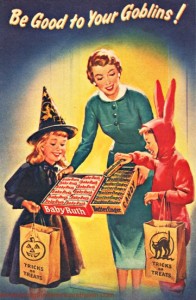 After the war, civic leaders continued their campaigns for “safe and sane” Halloween activities. Halloween became, more and more during the 1940s and 1950s, a holiday for children to enjoy rather than one for pranksters. In the fifties, the impetus moved back to school and family activities. Trick or treating became a firmly entrenched nationwide custom. Its implied threat became less and less a reality in most communities; in others, the “tricks” were relegated to a Mischief Night and the “treats” to Halloween itself.
After the war, civic leaders continued their campaigns for “safe and sane” Halloween activities. Halloween became, more and more during the 1940s and 1950s, a holiday for children to enjoy rather than one for pranksters. In the fifties, the impetus moved back to school and family activities. Trick or treating became a firmly entrenched nationwide custom. Its implied threat became less and less a reality in most communities; in others, the “tricks” were relegated to a Mischief Night and the “treats” to Halloween itself.
By the 1960s, when most Americans were no longer particularly frightened by supernatural entities, a new element arose: the fear of sadistic or deranged adults intent on harming children. These “urban legends” were originally given impetus by incidents with some truth, but no real malicious intent. In the mid-sixties, the fear was of poisoned candy. In 1967 the focus became the threat of razors and sharp objects hidden in apples (and later candy). In 1973-74, completely unfounded rumors of a Satanic cults plotting to kidnap and sacrifice children on Halloween arose. These new legends altered Halloween celebrations. Trick or treat was banned entirely in some areas; safety factors and “safe” festivities were stressed.
Some conservative fundamentalist Christian groups also began to come out against celebrating Halloween in the 1970s. Many churches, including fundamentalist denominations, had previously sponsored “wholesome” community Halloween activities. Some of the anti-Halloween propaganda from these groups also tended toward anti-Catholicism. In the 1990s some public schools reacted to parental concerns about Halloween—sometimes linked to promoting violence and violent images—by substituting “Harvest Festivals” for Halloween celebrations.
In some parts of the world, All Saints Day and All Souls Day are still important days of religious observance, and in the U.S. there is still a Christian religious aspect to the holiday as marked by Roman Catholics, Anglicans, and Episcopalians. Modern Wiccans and other neopagans consider Samhain a major holiday. But Halloween as we now know it is a secular holiday with no religious significance for most. In the late nineties, there were even some unsuccessful organized efforts made to change the celebration of Halloween to the last Saturday in October, citing practical, safety, and merchandising advantages.
In many ways, modern Halloween has actually become two separate celebrations. One is for adults, the other is child-oriented. For both, Halloween is often celebrated more than just one night. The entire month of October is now full of events and entertainment.
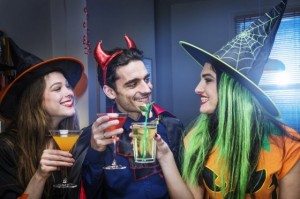 For grown-ups, Halloween is now the third biggest “party day” (after New Year’s and Super Bowl Sunday) of the year. According to the National Retail Federation, young adults (age 18-24 years) are more likely than any other age group to throw or attend a party (55.4%). Halloween marketing began to shift toward adults in the seventies. By 1980, a quarter of adults aged 18 to 40 wore some form of costume; by 1986, it was around 60%. In 2010, Americans spent an estimated $800 million on costumes for children, $1 billion on costumes for adults. Adults celebrate not only at home, but at work; nightclubs, restaurants, and bars host Halloween events. Haunted attractions—from local charity-run haunted locations to more extravagant for-profit attractions and major commercial theme parks—now number in the thousands. The commercial enterprises have become a multi-million dollar industry. Although some cater to youngsters, most are aimed at scaring teens and young adults.
For grown-ups, Halloween is now the third biggest “party day” (after New Year’s and Super Bowl Sunday) of the year. According to the National Retail Federation, young adults (age 18-24 years) are more likely than any other age group to throw or attend a party (55.4%). Halloween marketing began to shift toward adults in the seventies. By 1980, a quarter of adults aged 18 to 40 wore some form of costume; by 1986, it was around 60%. In 2010, Americans spent an estimated $800 million on costumes for children, $1 billion on costumes for adults. Adults celebrate not only at home, but at work; nightclubs, restaurants, and bars host Halloween events. Haunted attractions—from local charity-run haunted locations to more extravagant for-profit attractions and major commercial theme parks—now number in the thousands. The commercial enterprises have become a multi-million dollar industry. Although some cater to youngsters, most are aimed at scaring teens and young adults.
The kids’ version of Halloween evolves around masquerade, parties, family-oriented events (hayrides, not-very-scary haunted houses, and pumpkin patches), and trick or treating—even if the latter is sometimes restricted, adult-controlled, and made entirely “safe.” At the same time, many of the negative myths that arose in the previous three decades were, by the end of the nineties, beginning to be debunked by the media.
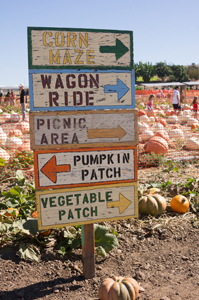 A fairly recent innovation, Halloween-themed “agritainment” and has helped offset the loss of traditional farm income, often in a big way. Offering far more than a simple hayride through harvested fields, there are now “fall family adventure farms,” complicated corn mazes, pick-it-yourself pumpkin fields, haunted barns and stables, and usually plenty of tasty edibles.
A fairly recent innovation, Halloween-themed “agritainment” and has helped offset the loss of traditional farm income, often in a big way. Offering far more than a simple hayride through harvested fields, there are now “fall family adventure farms,” complicated corn mazes, pick-it-yourself pumpkin fields, haunted barns and stables, and usually plenty of tasty edibles.
“Educational” events with a Halloween theme abound. Parks, zoos, museums, and nature study facilities teach both adults and children about traditionally scary creatures likes owls, spiders, snakes and bats. There are ghost-tours related to historic locations and events; some older cemeteries even use Halloween as an excuse to nurture an appreciation of history.
“Trick or Treat for UNICEF” is no longer the only charitable event using Halloween for a good cause. There are blood drives with vampires, programs to collect used costumes to allow homeless and disadvantaged children to dress up for the holiday, balls to raise funds for AIDS research, and more.
Halloween remains a predominately North American holiday. It is popular in England: By 2010, the British grocery chain Tesco estimated its Halloween sales had almost tripled—to £55 million—since 2005. (In 2010, they sold 1.4 million pumpkins.) In terms of retail sales, only Christmas and Easter are bigger. Ghost walks, pumpkin carving, dance parties, club nights, and similar events are common. Trick or treating was once widespread, but the last few years have seen its decline. Blame for this new dislike may lie with parental disdain for teaching children the rude behavior of “begging” and what appears to be a rise in egging, flour bombs, and other “anti-social” behavior. “No Trick or Treat Here” posters have been made widely available in many communities. Evidently British youths have put the “tricks” back into the custom.
The Japanese are now starting to celebrate Halloween to some extent. Halloween bento—a meal served in a box—can be bought along with seasonal pumpkin-flavored chocolate and cookies featuring pictures of koalas dressed in Halloween costumes. Trick or treating is not commonplace, but dressing up in costumes for parades is popular.
In Romania, where Dracula has become a tourist industry, adult nightclubs throw parties with bat and vampire themes.
In the mid-1990s, Halloween seemed to be catching on in France. American companies like McDonald’s, and Disneyland Paris had Halloween themes; some nightclubs and bars had events. But, from the beginning, French media denounced Halloween as an American marketing gimmick. In 2006, the newspaper Le Monde pronounced Halloween “more or less buried” in France.
In the last few years, Halloween has been creeping into Austria, Belgium, Germany, Italy, Norway, Sweden, and Italy, but is not widely celebrated. There has been some backlash in Europe against what is seen as yet another example of crass American commercialism undermining traditional culture and, in some cases, religion. Similarly, Halloween seems to have little chance to take hold “Down Under.” A 2009 survey by News.com.au asked: “Should Australia ditch Halloween as an event on the calendar?” More than 77% of the respondents replied, “Yes, It’s totally irrelevant.”
 For Americans, Halloween has manifested itself as an important—if still unofficial—holiday. We are just now beginning to seriously investigate its history and antecedents even as we adapt it to an ever-changing society and devise new traditions and customs with which to celebrate. What we do at Halloween—and what it does for us—varies from individual to individual and group to group depending on our beliefs, backgrounds, sexual orientation, even employment.
For Americans, Halloween has manifested itself as an important—if still unofficial—holiday. We are just now beginning to seriously investigate its history and antecedents even as we adapt it to an ever-changing society and devise new traditions and customs with which to celebrate. What we do at Halloween—and what it does for us—varies from individual to individual and group to group depending on our beliefs, backgrounds, sexual orientation, even employment.
There are certain rites of passage associated with Halloween as well. As we progress through different stages in life, we relate to Halloween in different ways. The day comes when we are “too old” for trick or treat, but that may mean we are ready for more adult activities. Young adults often mix the modern equivalent of “matchmaking” with Halloween celebrations. As we become parents ourselves, we pass on traditions, give out the treats, and make the costumes: we become responsible for supplying some of the magic ourselves. At the same time, we discover we still have a need to be, for just one night, something other than what we usually are. Instead of becoming gatekeepers for a new generation, some adults extend the fantasy of Halloween far past the perimeters of age.
Whatever its history, Halloween is anything but a dead tradition. It is, perhaps, more alive and more meaningful now than ever before.
[This essay has been updated and considerably modified from an earlier version that appeared as “A Short History of Halloween” in October Dreams: A Celebration of Halloween, edited by Richard Chizmar and Robert Morrish, published by Cemetery Dance Publications in 2000.
If you are interested in learning more about the history of Halloween, I recommend only a handful of books . . . and avoiding a great deal of what you will find online. First and foremost is The Halloween Encyclopedia (Second Edition) by Lisa Morton (McFarland, 2011). I wish I’d had the first edition (2003) when I wrote “A Short History of Halloween”! Also by Morton: A Hallowe’en Anthology (McFarland, 2008). Full of original source materials, it may not appeal to the casual reader, but if you are a true Halloween enthusiast it is full of goodies. Halloween: An American Holiday, an American History (Pelican, 1999) and Halloween Nation: Behind the Scenes of America’s Fright Night (Pelican, 2011), both by Lesley Pratt Bannatyne are also recommended. Ballatyne’s A Halloween Reader: Poems, Stories, and Plays from Halloween Past (Pelican, 2004) will, like Morton’s Anthology, appeal to dedicated Halloweenists.]
Paula Guran
June 2011
